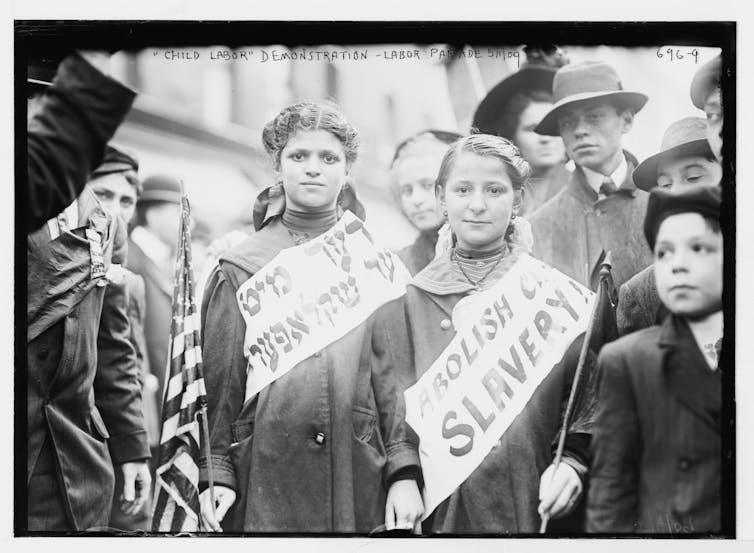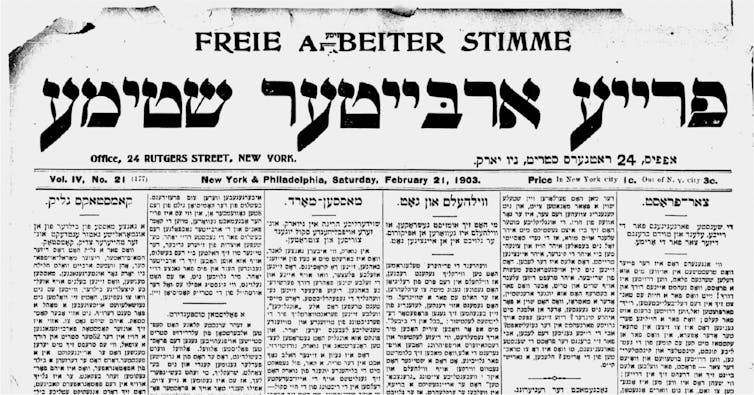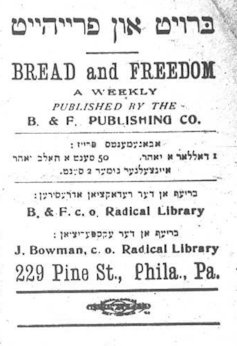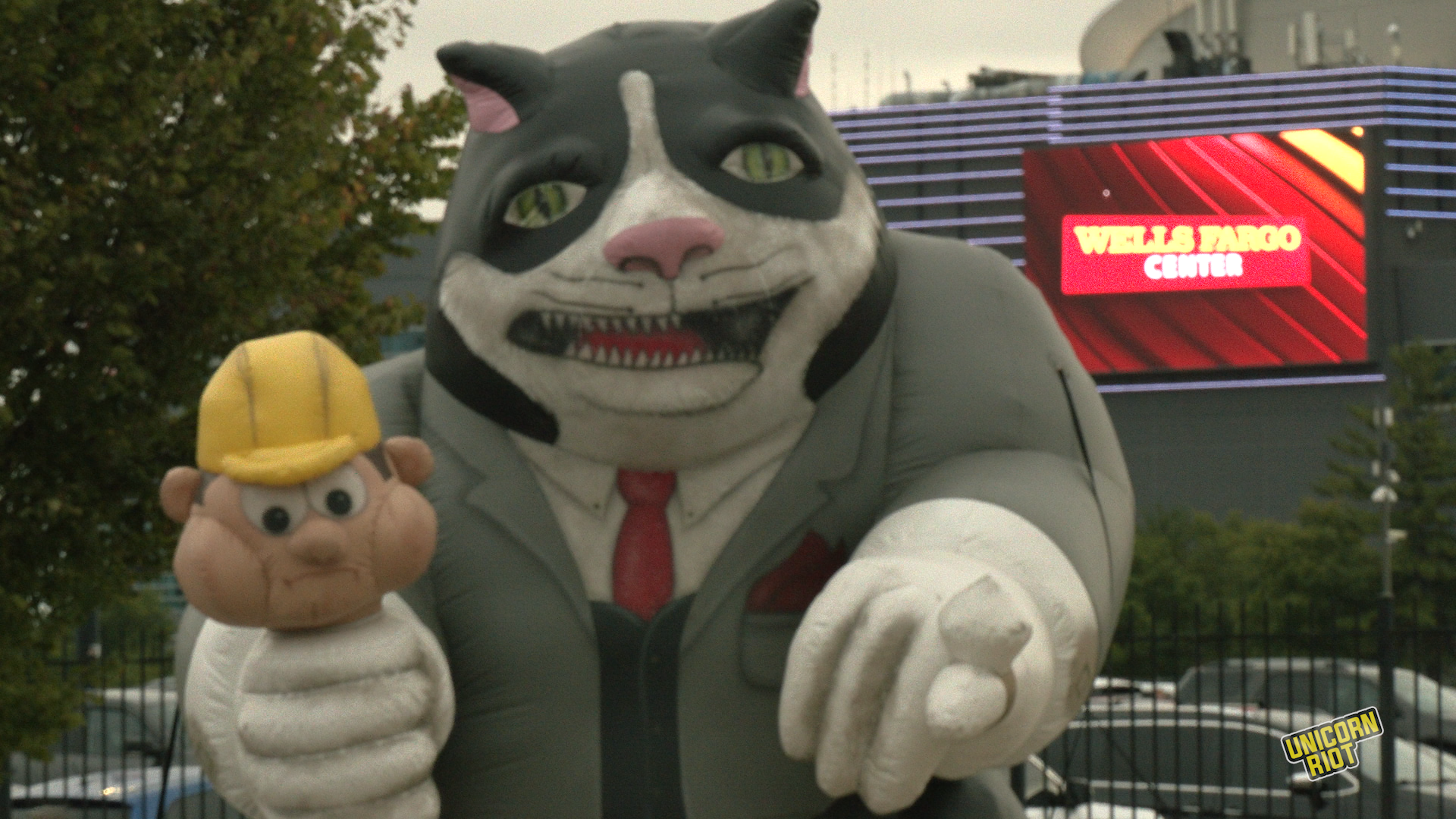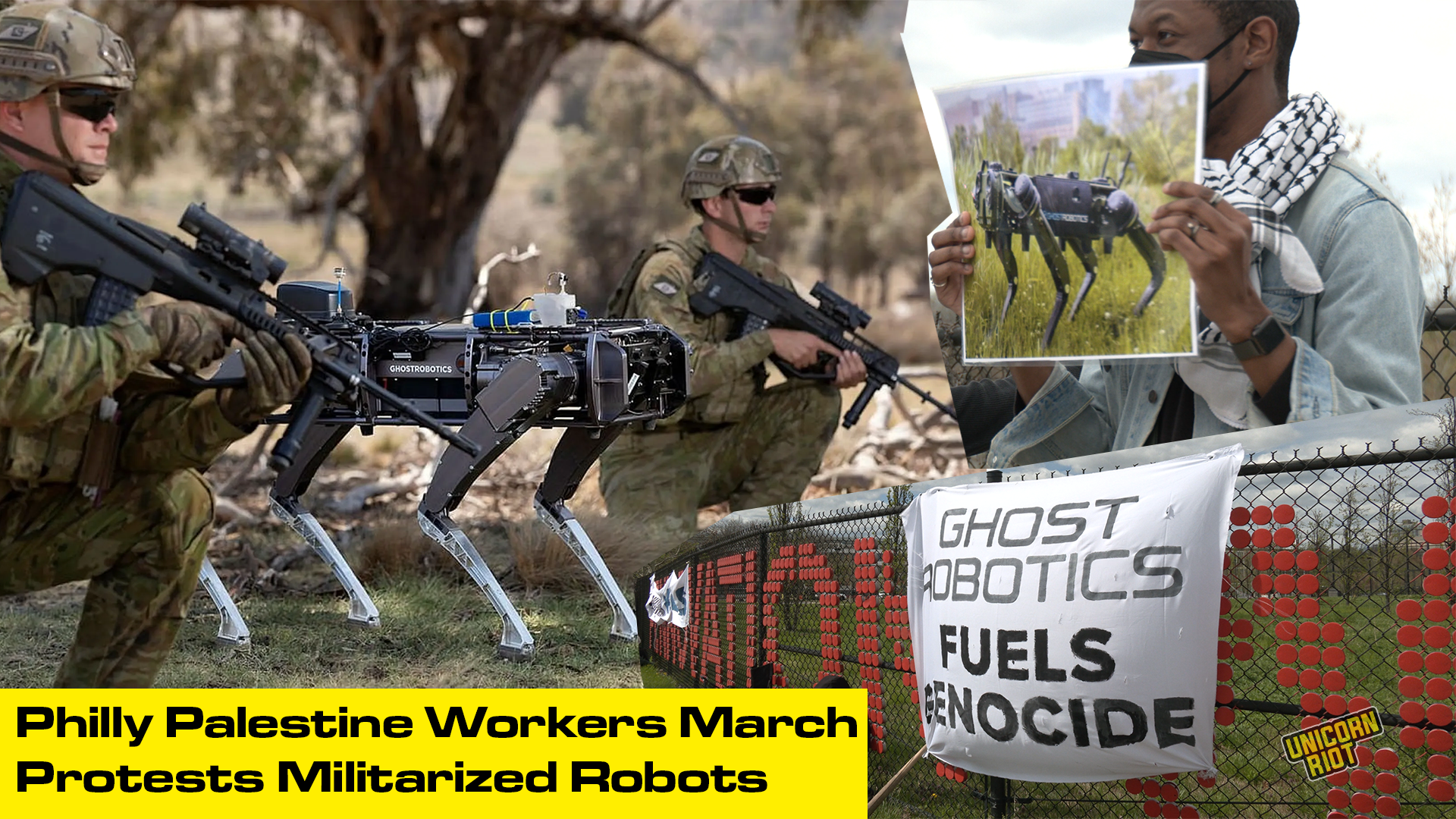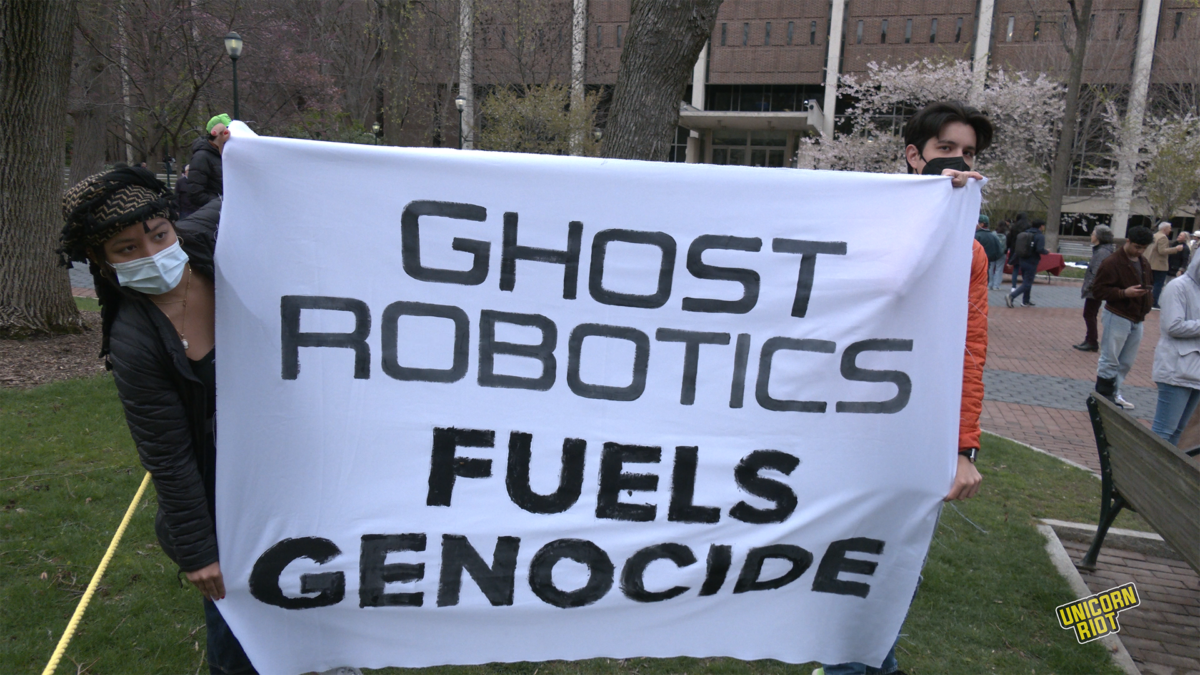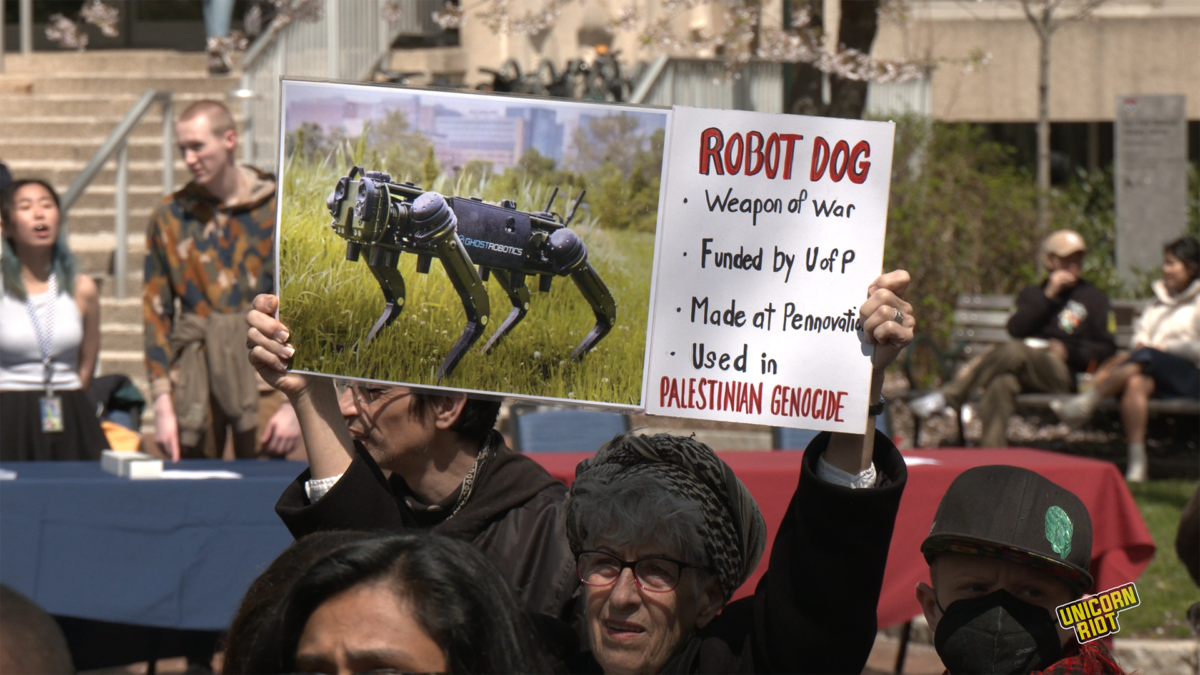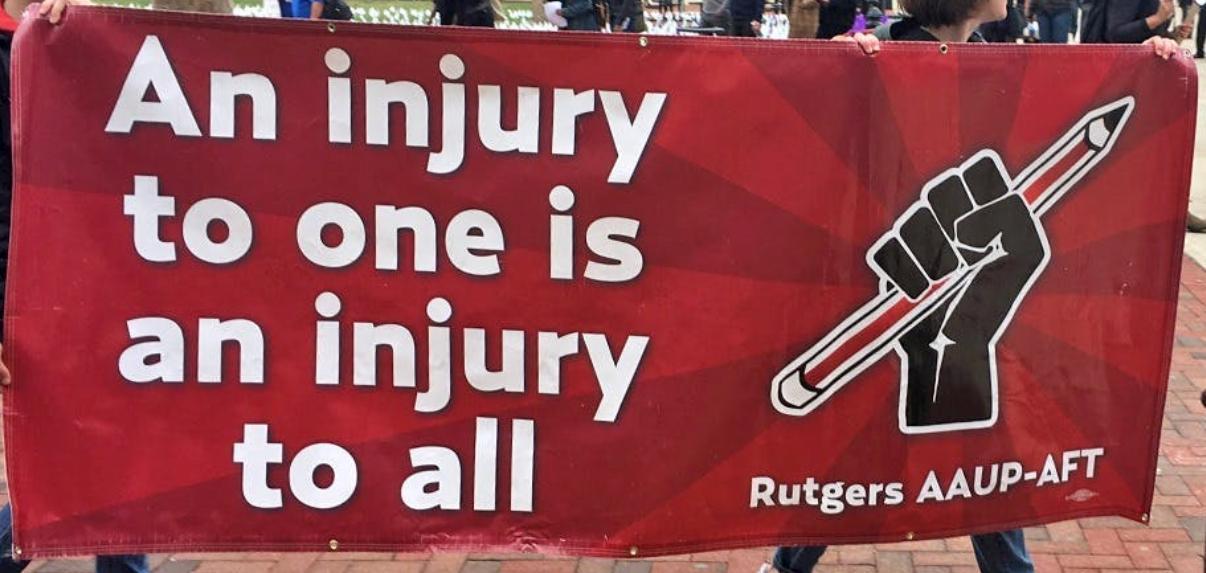from Unicorn Riot
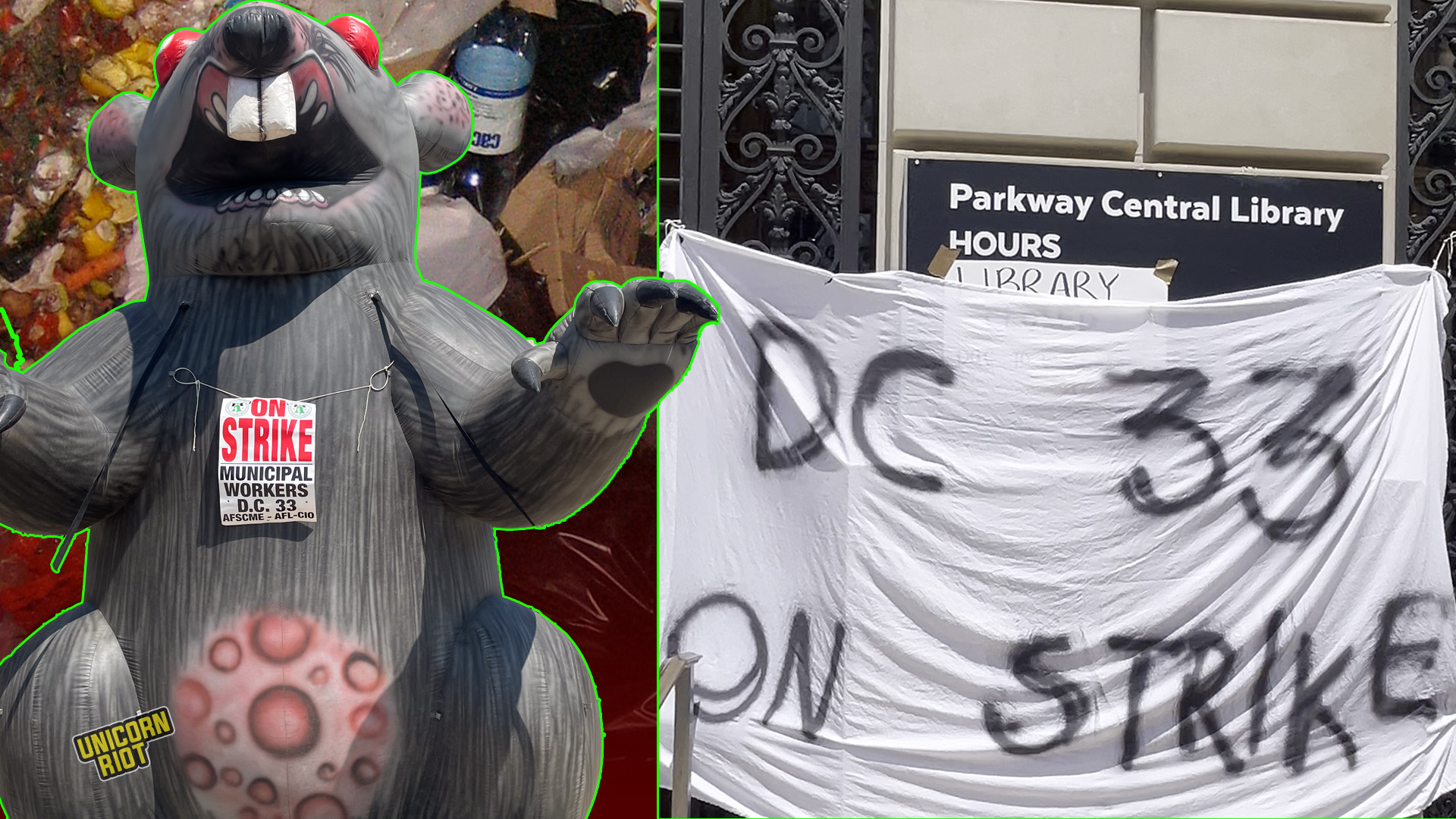
Philadelphia, PA — A working class uprising continued through Fourth of July celebration week in the “poorest big city” in the United States. Jammed locks at health centers, opened fire hydrants, slashed tires, blocked trucks, and blocked access to work sites were just a few allegations brought by City Solicitor Renee Garcia in a recent press conference. Three injunctions have been filed that require a limited number of essential workers to return to work and a third aims to stop “unlawful activity” by union members who are striking for better pay and benefits. Despite court orders, the city had received numerous reports of noncompliance, according to Garcia, “and they have not stopped.”
“At one location where we had employees locked inside, [striking workers] shut off the water from the outside and then parked their car over the valve [to prevent it being turned back on]. It’s not legal activity… Just two hours ago, they breached the fence, they came in and started taking trash from dumpsters and compactors and throwing it on the floor.”
Philadelphia City Solicitor Renee Garcia, July 2, 2025
Meanwhile, trash continues to pile up around the city.
Failed contract negotiations have led nearly 10,000 members of AFSCME District Council 33 (DC33), the union representing blue-collar Philadelphia city workers, to walk off the job.
DC33 represents an array of city service workers including librarians, sanitation, the water department, 911 emergency dispatch, school crossing guards, airport maintenance, and street maintenance.
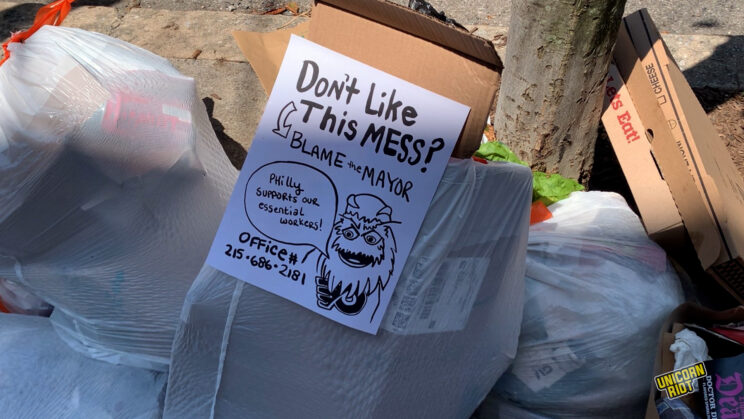
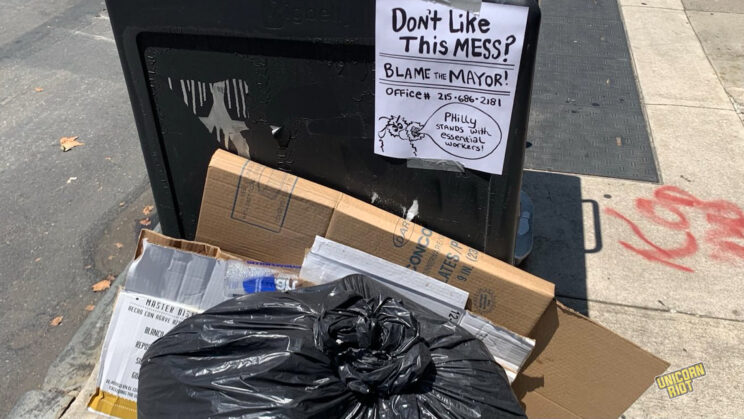
The historic strike by the largest working-class municipal union in Philly is the first of its kind in nearly 40 years. Trash pick-ups, street repairs, and other city services ground to a halt overnight.
Picket lines have been active throughout the city since July 1. Sanitation sites and public libraries have reportedly been chained and locked to prevent scabs – non-union workers brought in to replace strikers – from breaking union picket lines. The official Free Library of Philadelphia website listed over forty locations closed with “work stoppage” as the reason.
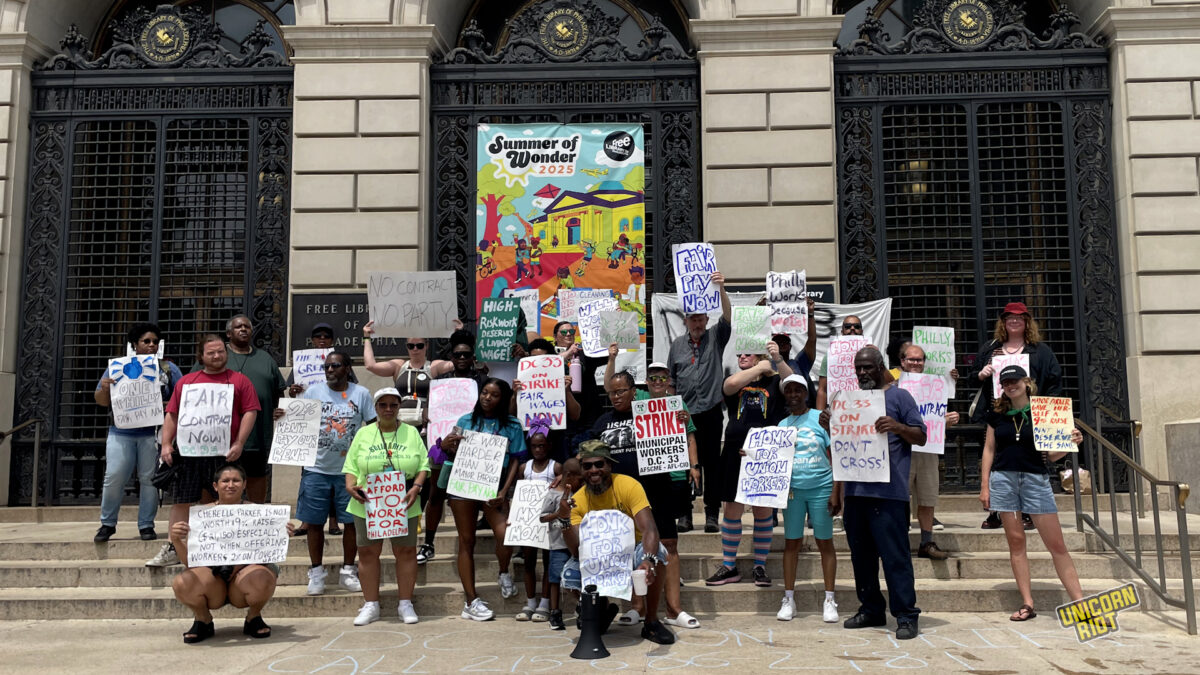
Video from NBC10 shows a tense moment from Tuesday, July 1 when management at the Department of Sanitation in the Strawberry Mansion neighborhood tried to enter the Sanitation Convenience Center while union members confront the person. “We’re on strike, man, you know the rules. We not moving nothing… and that’s what it is. Respectfully…” The clash lasted a few moments before management was turned away and picketers locked the gate shut. “Tell that to the Mayor. It’s the Mayor’s fault, not ours. We’re on strike… and that’s what we’re gonna do until we get a fair contract.”
In a conjuring of C.L.R James’ notion of “proletarian self-activity,” workers throughout the city have taken matters into their own hands, leading to at least two arrests.
On the 3900 block of Ford Road, union worker Carnell Wilder, 59, was arrested in connection to an incident involving a Philadelphia Gas Works employee. Wilder allegedly approached the PGW worker, who was operating a digger loader and asked “why aren’t you striking?” before proceeding to deflate one of the tires with a knife, according to unverified police claims reported in corporate media. Wilder was arrested and transported to a medical center for hand injuries.
The following day, July 2, Jeanette Coppinger, a librarian assistant and union member, was arrested after allegedly blocking the entrance to the Northeast Regional Library on Cottman Avenue. Local news reported that a sheriff’s deputy read the injunction against blocking entry during the picket, but Coppinger refused to move. In court, Coppinger affirmed that she willfully violated the order “to make a statement.”
Even the city medical examiners have walked out. City attorneys complained “cooled storage for dead bodies is getting crowded, and there is a ‘backlog’ of cadavers that need to be examined in Philadelphia’s morgue that has increased due to the strike.”
A judge agreed, “[it] creates a clear and present danger or threat to the health, safety or welfare of the public,” and ordered some staff to “cross any picket lines established by Defendants or any other person if necessary to complete the full, faithful, and proper performance of their duties of employment for the City.”
Union City Workers’ Wages Well Below Local “Living Wage”
DC33 is the lowest paid of Philly’s four municipal unions and the only municipal union with majority-Black membership, the Philadelphia Inquirer previously reported. According to a recent report by NBC10, sanitation workers in Philadelphia earn the lowest salary of any major city in the US; they typically earn between $18-20 an hour. A living wage in Philadelphia County for a family with one child stands closer to $38.60, according to MIT’s Living Wage Calculator.
DC33 is currently asking for a 5% increases over each of the next four years; the city offered 2.75%, 3% and again 3% over three years, according to a July 3 Billy Penn report.
On day one of the strike in front of the Parkway Central Library at 1901 Vine Street, one union member carried her child while admonishing the current pay rate as “not enough to even pay for diapers.”
This isn’t the first time Mayor Cherelle Parker, the first Black woman elected mayor of Philadelphia, has faced organized community resistance.
Last year, Parker’s unpopular push to gentrify Chinatown with a 76ers stadium proposal was a disaster for the city, as she spent hundreds of thousands of tax dollars trying to convince her constituents that selling out Chinatown with a new stadium was a good idea. Chinatown residents and their allies rose to “Save Chinatown,” clashing with the mayor at press conferences, city council hearings and outside of City Hall. Despite heroic efforts from the Chinatown community, the stadium deal was approved last December. However, 76ers management reversed their decision with the city, humiliating the Parker administration.
Mayor Parker is again facing backlash after claiming that the city cannot afford the union’s proposal. Video is circulating on social media from 2021, where Parker is seen giving an impassioned speech in support of fair wages for DC33 and even quotes James Baldwin, “I can’t believe what you say, because I see what you do!”
Meanwhile, Parker created 16 new positions within her administration that offer six figure salaries. Parker, herself, enjoys a 9% salary increase that was carried through during the last month of the previous administration. Last year, she received an additional 3.1% Cost of Living Adjustment bringing her salary to $269,708.
Data from the Bureau of Labor Statistics show that garbage collectors are more likely to die on the job than police. Yet, at $64,982, police officers in Philadelphia receive a starting salary of over $20,000 higher than the city’s sanitation workers. This year’s city budget also includes $1.3 million for new police uniforms.
In Philly, the average sanitation worker makes between $39,000-42,000/year. A 5% increase, the union’s current demand, would bring that number up by about $2,100/year, on average. As negotiations continue, the Mayor demanded that “we must restore order before bargaining.” DC33 responded: “Order isn’t the issue—poverty pay is.”
No deal was on the table by the time July 4 approached, where the Wawa convenience store chain hosts its annual music festival celebration called Made in America.
In solidarity with the workers, LL Cool J announced that he would no longer be headlining the Fourth of July event. “I understand there’s a lot going on in Philadelphia right now, and you know, I never, ever, ever want to disappoint my fans, and especially in Philadelphia,” he said in a video on social media. “Y’all mean too much to me, but there’s absolutely no way that I could perform, cross a picket line and pick up money when I know that people are out there fighting for a living wage. I’m not doing that, you know?”
At 2 p.m., the union organized a picket line directly outside of the festival’s entrance, near the Free Library on 1901 Parkway. Scabby – a cartoonish inflatable rat used to shame union-busting employers – made an appearance while hundreds of picketers and their supporters gathered. Union members, a labor historian and even a small band playing old union hymns shared time on the mic.
PHILADELPHIA – #DC33 Strike Day 4:
SCABBY THE RAT joins striking @afscme33 workers (garbage collectors, water plant operators, etc) & supporters picketing Wawa’s ‘Welcome America’ July 4 party.
Mayor Cherelle Parker has yet to agree to striker’s demands for livable pay. pic.twitter.com/tOKTgBblqn
— UNICORN RIOT (@UR_Ninja) July 4, 2025
By around 3:20 p.m., another performer and Philly native, Jazmine Sullivan, expressed her solidarity with the workers and refused to cross the picket line to perform. Her Instagram story read, “In this life we are only measured by how we uphold our morals and standards, by what we choose to fight for through participation or protest. Today I choose not to perform at the Wawa Welcome America concert and stand with Philly’s DC33 until the city and union find a way to bring fair living wages to our working class. I love my city and I believe in you. Hopefully we will get to celebrate when things are better.”
As uncollected trash keeps piling up, strikers with @afscme33 are encouraging supporters to keep contacting Cherelle Parker’s office to help apply pressure to agree to an 8 percent raise for garbage collectors & other essential workers who often struggle to make ends meet. pic.twitter.com/TL3KHdcA0U
— UNICORN RIOT (@UR_Ninja) July 4, 2025
The historical significance of a sanitation worker strike in the U.S. cannot be overstated. The 1,300-strong sanitation strike in Memphis, Tennessee, inspired Martin Luther King to give his 1968, “I’ve Been to the Mountaintop” speech. “Don’t let anybody tell you to go back on the job and paternalistically say, ‘Now, you are my men and I’m going to do the right thing for you. Just come on back on the job.’ Don’t go back on the job until the demands are met. Never forget that freedom is not something that is voluntarily given by the oppressor. It is something that must be demanded by the oppressed.”
“The person who picks up our garbage, in the final analysis, is as significant as the physician, for if he doesn’t do his job, diseases are rampant. All labor has dignity.”
Martin Luther King Jr., March 18, 1968
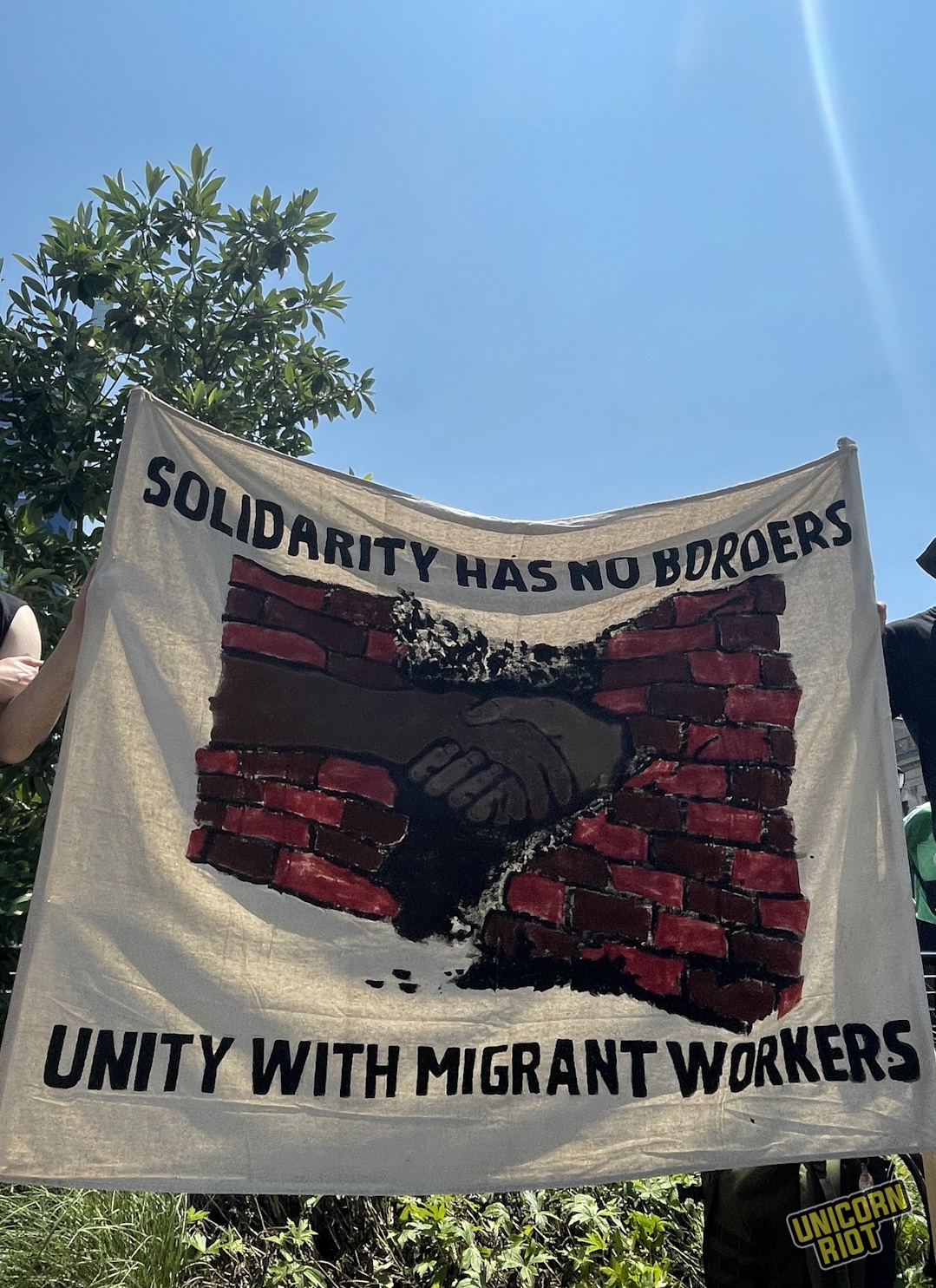
Standing with members of the sanitation unit on July 6, Greg Boulware, president of AFSCME DC33, strengthened the resolve of the strikers.
“We see scales, charts and graphs all over the country that are highlighting how far below the men and women who work in the City of Philadelphia are living below the living wage scale. That has to change … I don’t care how many SCABS they get to try to do our work, they can’t do the work that District Council 33 does.”
Greg Boulware, President, AFSCME District Council 33
On Monday, July 7 – the seventh day of the strike – three activists from the environmentalist Sunrise Movement had a “Special Delivery” for Mayor Parker. Inside City Hall, overflowing trash bags were dragged in front of room 185. The bags carried a written message, “MEET DC33 DEMANDS.” A sit-in had begun.
According to a Sunrise Movement Instagram post, “we picked up garbage from Piccoli Playground in North Philly, one of the mayor’s temporary dumpsites where trash continues to pile up and put us at risk.” The three were quickly arrested. One yelled, “Workers deserve dignity! Cherelle, pay your workers!” All three were released later that evening.
The same morning, in the Point Breeze section of South Philadelphia, striking workers reported a large police presence outside of Queens Memorial Library. One union member said that no scabs had been able to cross the picket. “SCAB LINE” was written in chalk at the library’s entrance. “WE SEE YOU SCABS – WE REMEMBER” was chalked in large letters on an adjacent wall. As of July 7th, the Philadelphia Free Library website listed 48 library locations closed due to “union work stoppage.”
Whispers of a city-wide general strike loom as other work sectors experience labor disputes. ASFCME DC47 plans for a strike authorization vote on Thursday, which would add 3,000 more strike-ready workers.
World Café Live is striking for union recognition (organizing with IATSE Local 8). The Philadelphia Federation of Teachers has voted to authorize a strike if they don’t come to a new contract agreement before their current one expires in August.
Penn Museum Workers United AFSCME Local 397, who voted to strike this Wednesday, went to social media to express solidarity with DC33: “The working people of Philadelphia deserve more than the crumbs Mayor Parker and Penn are putting on the table.”
As the workers maintain their resolve with “One day longer, one day stronger,” Philadelphians continue to defy the Mayor’s orders to not put trash on the curb. Block by block, signs and notes are shared between neighbors expressing support for the striking sanitation workers. In the City of Brotherly Love, solidarity remains a love language for strike summer 2025.
Learn more about the local history of sanitation strikes from Michaela Althouse in the Philly Voice: Philly’s history of city worker strikes included Molotov cocktails, suburban weddings and 45,000 tons of garbage
Cover images by R. Martin. Garbage background via Perez Partensky, Wikimedia Commons. Composition by Dan Feidt.

